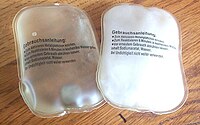
Photo from wikipedia
Abstract For fast waste heat recovery in 100–150 °C the unconstrained melting of phase change material (PCM) composite is investigated. The composite is based on Erythritol PCM with 2.5% volume fraction… Click to show full abstract
Abstract For fast waste heat recovery in 100–150 °C the unconstrained melting of phase change material (PCM) composite is investigated. The composite is based on Erythritol PCM with 2.5% volume fraction of copper nano-additive. This PCM composite is referred as nano-enhanced phase change material (NEPCM). The unconstrained melting in presence of nano-additives is modelled by developing a novel continuum model that accounts for phase change, bulk solid sinking and close-contact melting. By using a modified form of conservative energy equation different solid and liquid phase thermal properties are employed in the model. The predicted sinking pattern of the bulk solid compares well with the benchmark experimental result on n-octadecane PCM. The thermal field because of solid sinking is analyzed, and a high melting rate at reservoir bottom is observed due to close-contact melting. The energy behavior is analyzed in detail by presenting a comparison of global and local thermal and flow fields, and melt fraction distribution in PCM and NEPCM. For the melting process, the effect of the operational parameter is found to be more deterministic than the geometrical parameter. Overall, NEPCM melting completes earlier than PCM melting, however, there is a trade-off between the charging rate and the storage capacity for the NEPCM. System's performance is analyzed with the help of thermal performance parameters.
Journal Title: Journal of Molecular Liquids
Year Published: 2019
Link to full text (if available)
Share on Social Media: Sign Up to like & get
recommendations!